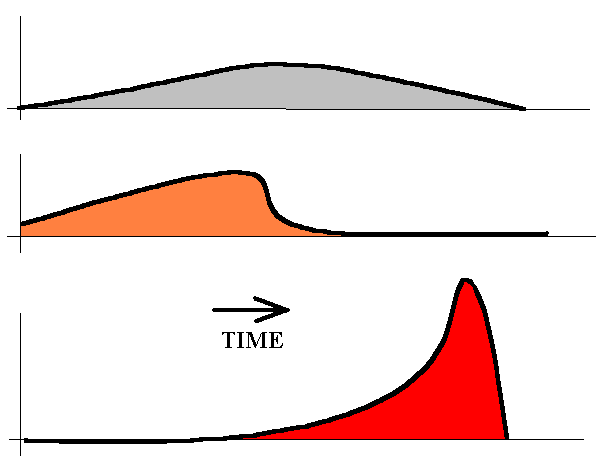
Explosion intensity (top) in air, in water (middle) and bottom a super sonic shock wave in water (aprox. scale and position).
In film, The Score, Robert de Nero plays a master safe cracker who's talked into doing one last job before he retires - he has to steal a gold statue stored in a safe in a high security building. He manages to fool the security and get to the safe. However, instead of blowing the door off with dynamite, he drills a hole into the top of the safe and tapping into the room's sprinkler system fills the safe up with water. He then places a test tube of explosive through the hole into the safe and blows it up from the inside out! So is there anything to be gained by doing this or is it just a bit of Hollywood Science?
Modern safe doors are made of extremely thick, strong hard steel and it would take a very long time to drill a large hole into this. In the film de Niro only needs to drill one hole in the top of the safe quickly. It may well be that the safe is thinner at the top making this easier.
What about the explosives? In fact, more energy is produced burning butter than the same amount of explosives such as TNT or Nitro glycerine! Contrary to what you might think explosives don't generally produce more energy than other chemical reactions they just react very much more quickly. An explosive then is a very fast reaction that produces a great deal of gases and heat. One volume of nitroglycerine produces about 10,000 volumes of hot gas at 3000 C when detonated. The heat expands the gases producing enormous pressures the explosion. Explosives such as TNT and nitro also have their own supply of oxygen liberated by their decomposition and so they would work just as well on the airless Moon or for that matter in a safe full of water. So providing he keeps the detonator dry (the test tube) he should be ok with the explosives for this stunt.
What about the water? Well the next time you pump up the tires on your bike try putting your finger over the end of the pump. You will find that you can compress the air without much effort. Now suck up some water into the pump and do the same thing. You just can't compress water in the same way because liquid densities are not far off that of solids. So the water in the safe should transfer the explosive energy more effectively than air.

The speed of sound in water is about five times faster than in air so if you let off an explosion in a safe full of water the blast pulse would have less time to spread out on its way to the walls of the container, maximising the impact. Further, you can get very fast super sonic shock waves in water which would be even better. All in all the water seems a very good idea indeed!
In our BBC TV series Hollywood Science we tried it out. We got two small 30cm metal safes but used plastic hinges and small explosive charges for our safety. We found that the safe with just air was un-harmed but when full of water the door flew off smashing the hinges. So Robert de Nero was really on to something. As Robert Llewellyn said in our TV series as far as the Science goes its looking pretty safe!.
References:
Try internet bookshops for a copy of John Read's excellent (but out-of-print) Explosives, Pelican 1942.
How teachers can use these articles in a lesson
Open University Hollywood Science web site
Call for clips - do you have a film clip that needs investigating?
home | diary | whats on | CSC summary | latest news